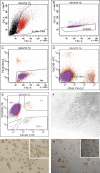Perivascular human endometrial mesenchymal stem cells express pathways relevant to self-renewal, lineage specification, and functional phenotype
- PMID: 22075475
- PMCID: PMC3290674
- DOI: 10.1095/biolreprod.111.095885
Perivascular human endometrial mesenchymal stem cells express pathways relevant to self-renewal, lineage specification, and functional phenotype
Abstract
Human endometrium regenerates on a cyclic basis from candidate stem/progenitors whose genetic programs are yet to be determined. A subpopulation of endometrial stromal cells, displaying key properties of mesenchymal stem cells (MSCs), has been characterized. The endometrial MSC (eMSC) is likely the precursor of the endometrial stromal fibroblast. The goal of this study was to determine the transcriptome and signaling pathways in the eMSC to understand its functional phenotype. Endometrial stromal cells from oocyte donors (n = 20) and patients undergoing benign gynecologic surgery (n = 7) were fluorescence-activated cell sorted into MCAM (CD146)(+)/PDGFRB(+) (eMSC), MCAM (CD146)(-)/PDGFRB(+) (fibroblast), and MCAM (CD146)(+)/PDGFRB(-) (endothelial) populations. The eMSC population contained clonogenic cells with a mesenchymal phenotype differentiating into adipocytes when cultured in adipogenic medium. Gene expression profiling using Affymetrix Human Gene 1.0 ST arrays revealed 762 and 1518 significantly differentially expressed genes in eMSCs vs. stromal fibroblasts and eMSCs vs. endothelial cells, respectively. By principal component and hierarchical clustering analyses, eMSCs clustered with fibroblasts and distinctly from endothelial cells. Endometrial MSCs expressed pericyte markers and were localized by immunofluorescence to the perivascular space of endometrial small vessels. Endometrial MSCs also expressed genes involved in angiogenesis/vasculogenesis, steroid hormone/hypoxia responses, inflammation, immunomodulation, cell communication, and proteolysis/inhibition, and exhibited increased Notch, TGFB, IGF, Hedgehog, and G-protein-coupled receptor signaling pathways, characteristic of adult tissue MSC self-renewal and multipotency. Overall, the data support the eMSC as a clonogenic, multipotent pericyte that displays pathways of self-renewal and lineage specification, the potential to respond to conditions during endometrial desquamation and regeneration, and a genetic program predictive of its differentiated lineage, the stromal fibroblast.
Figures




References
-
- Hess AP, Nayak NR, Giudice LC. Oviduct and endometrium: cyclic changes in primate oviduct and endometrium. In: Knobil E, Neill JD (eds.), The Physiology of Reproduction, 3rd ed. San Diego: Academic Press; 2005: 337 382
-
- Talbi S, Hamilton AE, Vo KC, Tulac S, Overgaard MT, Dosiou C, Le Shay N, Nezhat CN, Kempson R, Lessey BA, Nayak NR, Giudice LC. Molecular phenotyping of human endometrium distinguishes menstrual cycle phases and underlying biological processes in normo-ovulatory women. Endocrinology 2006; 147 (3): 1097 1121 - PubMed
-
- Salamonsen LA, Giudice LC. “The curse”: a 21st century perspective of models of its molecular basis. Endocrinology 2010; 151: 4092 4095 - PubMed
Publication types
MeSH terms
Associated data
- Actions
Grants and funding
LinkOut - more resources
Full Text Sources
Molecular Biology Databases
Miscellaneous

